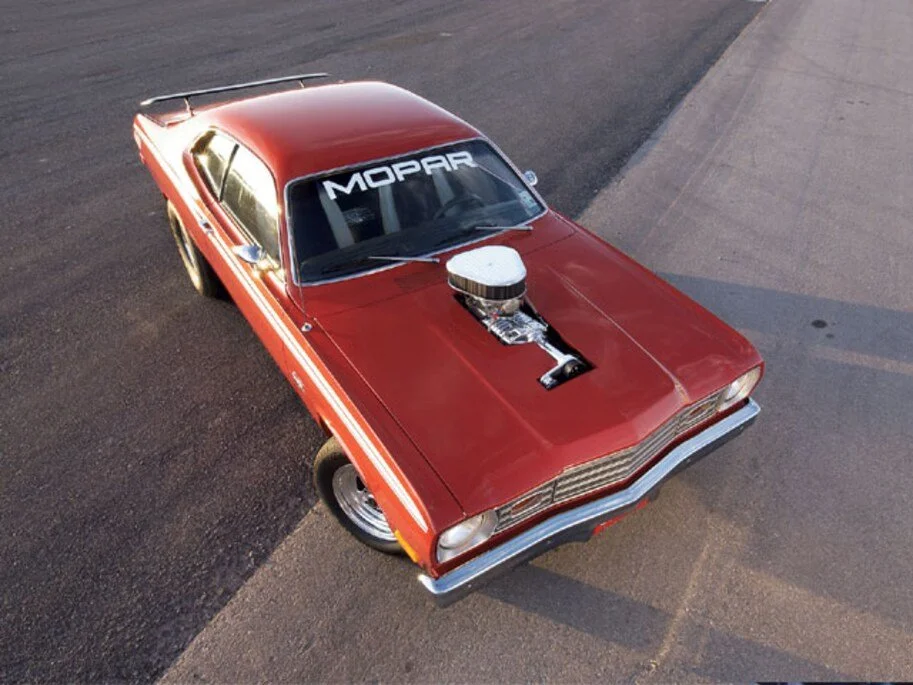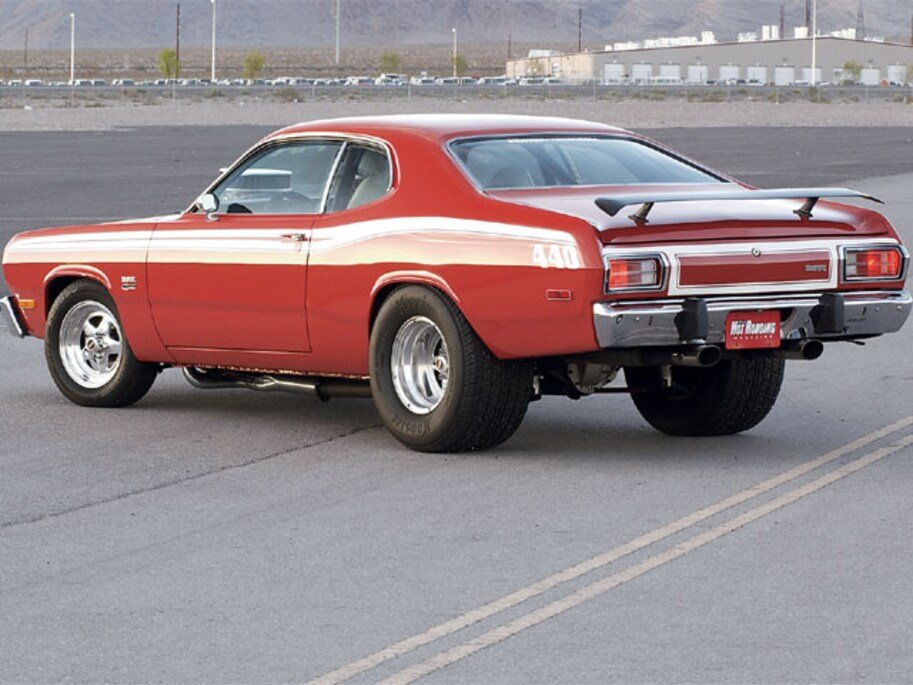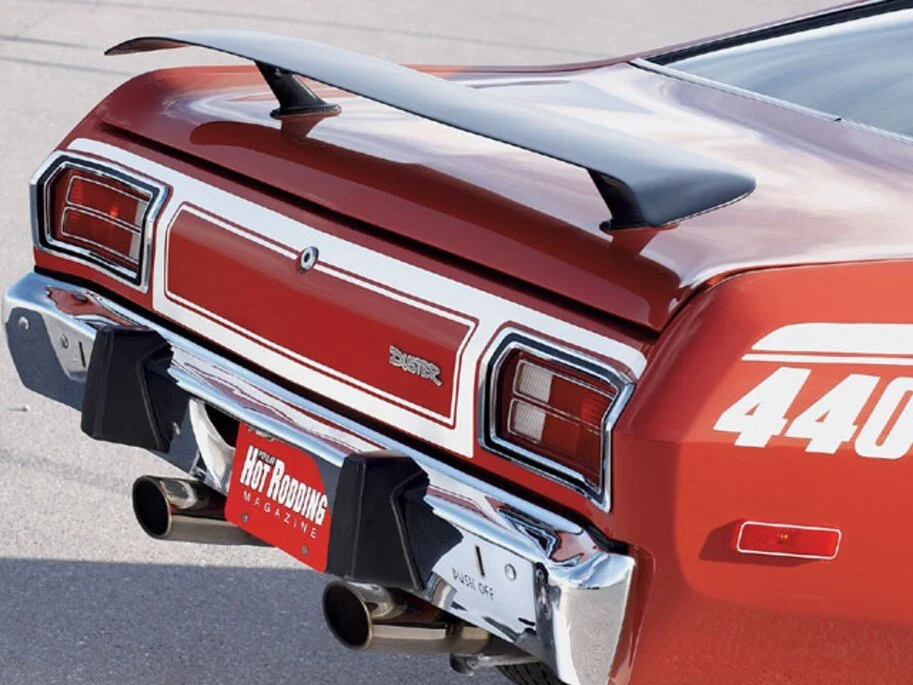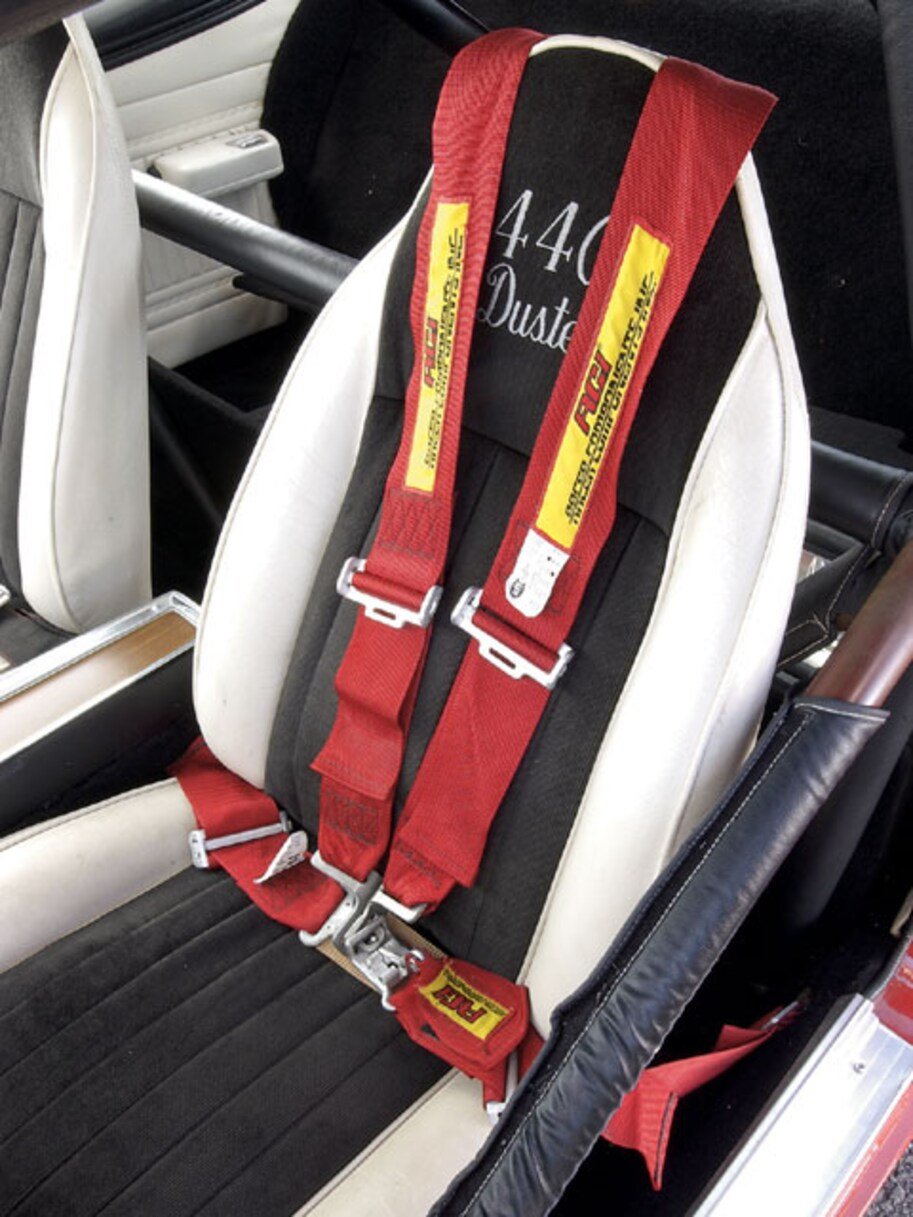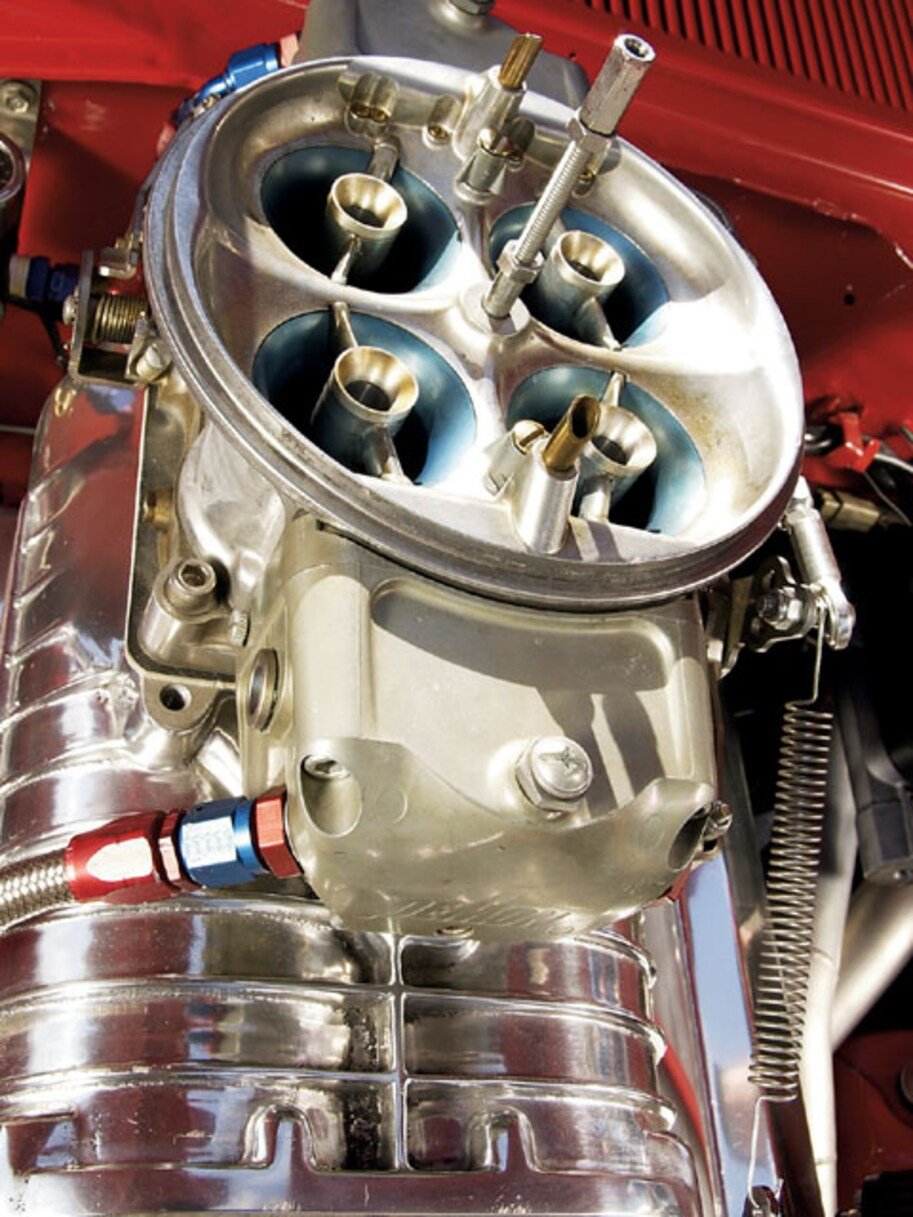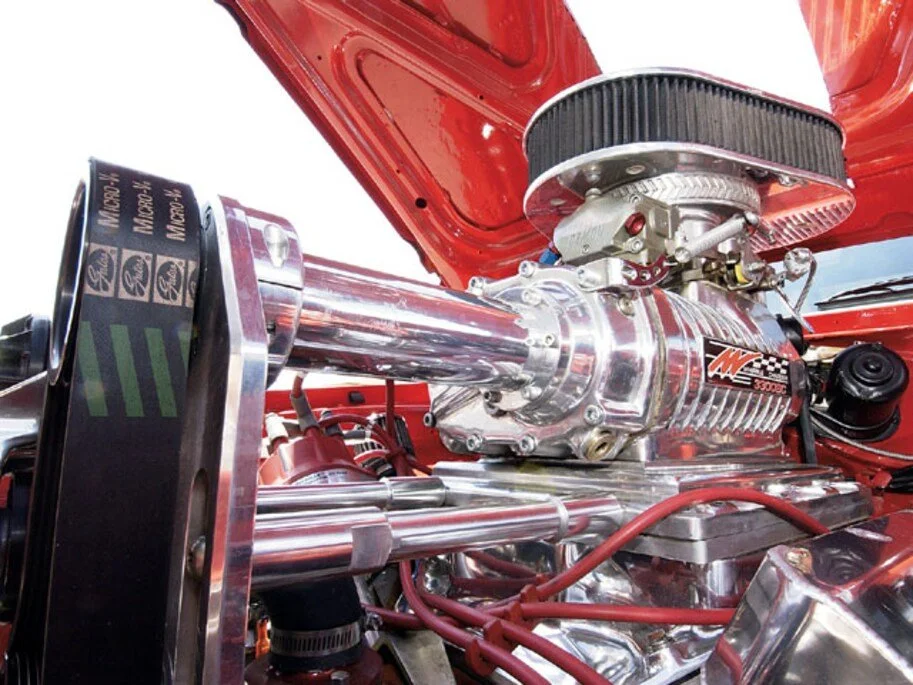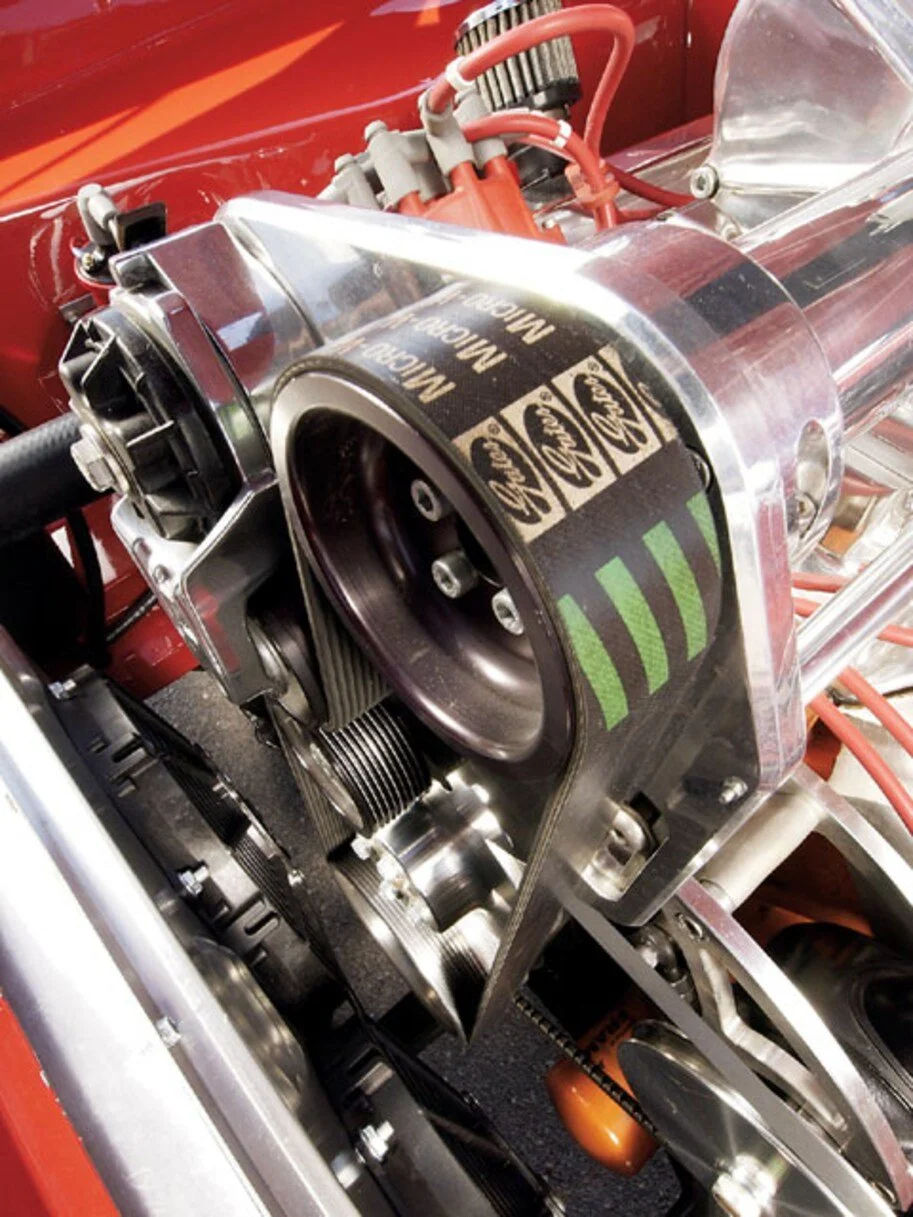
Featured in Popular Hot Rodding Magazine - August 2007
1973 Plymouth Duster - Red Dog
Matt Delaney's 9-Second Duster Signals Pro Street's Revival-Only This Time Around, It's Fast And Affordable.
Ro McGonegal- writer | Robert McGaffin - photographer | Sep 20, 2007
Some people go through cars like a tank of gasoline. Once a dream is realized, it loses its allure, brilliance, and interest, and so they move on to the next big thing. Sometimes it doesn't even get to that point, but others are far less fickle. They form a primal bond with their machines, and are unable or unwilling to let go of them. Hot rods like this practically become a member of the family-nurtured, respected, and cherished for decades. In a real sense, they are children birthed of men.
Matt Delaney's '73 Duster is one such lucky devil. He's had many Mopars, but has had a soft spot for this car for more than 30 years-poking, building, and enjoying it unconditionally. He's gone completely through it at least twice, once in 1985 and again in 2004, earning the World of Wheels Best Street Driven in 1986 and 1989. He has also garnered Second Place in NHRA Division 4 points (1987, 1988, 1991), done the Hot Rod Power Tour, and raced in Super Pro at regional bracket finals. In 2002, Matt formed Delaney Auto Design (www.delaneyautodesign.com), a respected and highly visible force in the world of modified Chrysler products.
Through it all, the Duster has represented an inexpensive build. There is no mystery behind it, only hard labor. Matt and his pal Harrel Lamkin did all the grunt work, save a newly stitched interior. When it came time for a heavy thrash, Matt called a few friends and bought a few cases of beer, much like most of us do. And come painting time, he rolled it around the corner to another buddy's garage.
What the ensemble built and improved all began with an advert on the old "Mannix" TV show. Matt saw a red Mopar A-body burning it up down a dirt road (hence "Duster"), and Cupid's arrow pierced his heart. A little while later, as a high school teenager, he bought a repo-a red 340 Duster. He raced anyone he could, and mostly won. Then "Big John" down at the Conoco station made a significant discovery. The ThermoQuad's huge secondaries weren't opening at all. "I went around the corner and floored it," says Matt. "The back end came out from underneath me, and my eyes turned to saucers. The next weekend, I found the two guys that had beaten me and surprised them.
Matt moved on the Duster with a perkier camshaft, a different intake manifold, a Holley carb, and headers, and because he was a cash-poor mechanical engineering student, he was only able to make one change at a time. The Duster even led a drone's life at times, towing his mom's Apache trailer to Florida and back. When Matt bought the car, gas was $0.55 per gallon. In his junior year in 1979, the tab had risen to more than $1.00. Combine that with those frisky 4.10 gears, and the proposition no longer made economical sense. Though he sold his 340 for a more pragmatic ride, the image of it refused to leave him. He then began dating his future wife, Cindy. They would drive by the new owner's house to look at the car, and Matt would tell her war stories. When they married, she bought it back as a surprise wedding gift. Some peach, that Cindy.
By the grapevine, Matt found out about an M-code Super Bee in the sheriff's compound that would soon be parted out. He played "Midnight Auto," grabbing the 440 and the Dana axle for a steal. In a weekend, he and Harrel had the motor and axle in place. One week later, they fired up the welder and installed the eight-point rollcage and wheeltubs.
The Duster ran 11 flat at 121, right out of the gate, and stayed that way until 1988. Then, Matt heard about a stroker engine and couldn't get the thought out of his head. The radio station Cindy worked for couldn't pay her, but advised her to take it out in trade with anyone she could get to advertise. One 482ci engine with BS-B1 cylinder heads and two couches later, she called it square.
Matt tells PHR, "She was happy with the couches, and I loved my new stroker, but the best I could manage was a 10.78 through the exhaust and on street tires. Traction had become a major issue. Though the car had gone from 1.60 to 1.40 60-foot times, the suspension really couldn't handle it. For the first time in three years, I wasn't on top of the points chase. I ordered a Chassis Engineering four-link and drove to Dallas to have it installed. Afterward, I realized it wasn't such a difficult job, and vowed that I'd never back away from anything when it came to modifying my car. From 1988 to 2004, it ran consistent 10.40s at 130. But by 2004, I was knee-deep in building retro-mods at Auto Design. The Duster became a red-headed stepchild, and my time with it was limited to Saturday night cruises."
Then the entire complexion of the project changed. Matt attended the SEMA show that year and hooked up with the Whipple supercharger guys, who expressed interest in building one of their systems for a 500ci wedge crate motor. The one Matt happened to have in his warehouse was quickly on its way to Fresno, California, for the forced-air conversion. In February 2006, the blower motor arrived, and by this time Mother Mopar was peddling its big-block wedge-aluminum cylinder heads. Matt got a pair.
"I knew that going from a solid roller to a hydraulic camshaft would limit the rpm range," says Matt. "I decided to use the flexible gearing that a Gear Vendors unit would provide, so that I could make it to the end of the track without running out of rpm. The combination proved as lethal as we'd hoped. The car is considerably faster, yet remains streetable. It's capable now of mid-9-second elapsed times at greater than 140 mph. And therein lies the rub-well, a couple of them: traction and NHRA rules. The car launches well, but the tires break loose at mid-track. With the current safety gear, when you break 140, you're immediately sent home. Now we need to throttlestop it back to 10-flats."
In the matching-numbers universe of most Mopar enthusiasts, Matt's a red dog, a spoiler of the first magnitude. He loves the form and function of vintage musclecars, but will not tolerate their chuck wagon ride, abysmal handling, and driveability issues. Period. "Dream and be determined, and there's no telling where you can go," he says. "It all began with one car and a stick welder."
WHERE THE MONEY WENT
Aluminum cylinder heads:$1,300
BDS blower intake manifold:$400
Billet Specialties air cleaner:$200
MSD Digital 6:$200
Milodon oil pan (swap meet):$20
Hensley Racing headers:$600
727 TorqueFlite, plus upgrades:1 case beer, help from friends
Gear Vendors Overdrive:$2,200
Turbo Action shifter:$250
Hughes torque converter:$350
Driveshaft:$150
20-gallon fuel cell:$209
Enlarging rear wheelwells (labor):1 case beer, help from friends
Bodywork and paint:5 cases beer, help from friends
Paint and supplies:$800
Upholstery:$700
Stewart Warner gauges:$200
Grant steering wheel:$110
Yamaha stereo system, complete (1985):$179Total:$25,421 (and 9 cases of beer)
1973 340 Duster:$1,750
Subframe connectors:$150
Wheeltubs:$75
Eight-point rollcage:$250
Dana 60 axlehousing, complete (1974):2 cases beer and $18
Dana 60 narrowing (labor):$75
Strange Engineering axles:$350
Strange coilovers:$400
0.88-inch torsion bars:$100
Aluminum strut rods:$90
Tie-rod link:$65
QA1 shock absorbers:$260
Wilwood brakes (complete):$600
Weld wheels:$700
Michelin front tires:$200
Hoosier rear tires:$370
Mopar 501 crate engine:$8,000
Used BG King Demon (including enlargement work):$600
Whipple 3300 supercharger:$3,500
SPECIFICATIONS
ENGINE
Type:Dodge displacing 501 ci (4.380 bore by 4.150 stroke)
Block:2004 Mopar Performance Crate Engin
eCompression ratio:9.0:1
Oiling:Milodon low-profile eight-quart oil pan, windage tray
Rotating assembly:4.150-inch stroke forged crank, forged H-beam rods, cast flat-top pistons
Cylinder heads:Mopar Stage VI CNC-ported aluminum, 2.25/1.81 valves
Camshaft:Mopar hydraulic, .550-inch lift, 245 duration at .050
Induction:BDS 6-71 intake manifold, Barry Grant King Demon RS 1,275 cfm carb, Billet Specialties air cleaner
Power-adder:Whipple 3300 supercharger
Ignition:MSD Pro Billet distributor, Digital 6 box, 34 degrees total timing
Exhaust:Hensley Racing, 3-inch exhaust system, Edelbrock RPM mufflers
Fasteners:ARP
Built by:Mopar Performance
DRIVETRAIN
Transmission:1969 727 TorqueFlite, bolt-in sprag, aluminum drum, manual valvebody, Hughes Performance 10-inch torque converter,
Driveshaft:custom steel, 4340 1350-series yokes
Rear axle:'69 Dana 60 housing narrowed 8 inches, clutch-type differential, 4.10:1 gears
CHASSIS
Front suspension:stock spindles, aluminum strut rods, and tie-rod link; .88-inch torsion bars; QA1 adjustable shocks
Rear suspension:four-link, Strange Engineering coilovers
Brakes:Wilwood 12-inch disc, front; stock drum, rear
WHEELS
Weld Drag Star 15x7, front; 15x12, rear
TIRES
Michelin 205/65R15, front; Hoosier Pro Street Radial 31.0/16.5R-15LT, rear
